Illinois Crop Update – June 28, 2024
Nicole Haverback – Watershed Outreach Associate
Henry County
Soil Conditions: Near Normal
After a few needed storms this week, Henry county received around 2 inches of rain with hail and wind impacting some areas
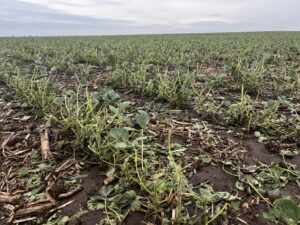
Figure 1: Hail damage soybeans- Annawan

Figure 2: Hail damage corn – Annawan
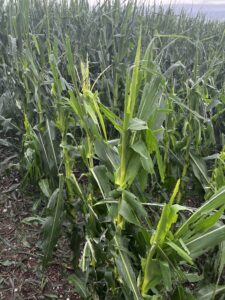
Figure 3: Hail damage corn- Annawan
Emily Hansen – Commercial Agriculture Educator
LaSalle County
Soil Conditions: Mildly Dry (soil is drier than normal, plant growth may have slowed)
It was another dry, hot week in LaSalle County. There were some showers on Tuesday, but not enough to make a huge difference. Despite this crops are only showing minimal signs of stress. Corn at the IVCC plots is at V7-V8, soy is at V5-6. Herbicide application last week has taken care of most of our weed problems, but there is still some waterhemp, marestail, and morning glory popping up in the field. I also spotted our first western corn rootworm beetle this week, but overall the field isn’t experiencing much pest pressure. Some much needed rain and cooler temperatures are in the forecast for later this week and next, which will hopefully alleviate some of the issues we’re seeing and speed up crop growth.
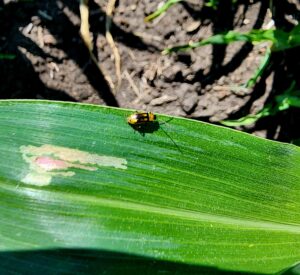
Figure 4: Western corn rootworm
Russ Higgins – Commercial Agriculture Educator
Grundy County
Soil Conditions: Mildly Wet (soil is wetter than normal, local vegetation is healthy)
It seems each week I write a completely different chapter for the 2024 growing season. Most areas in NE Illinois received precipitation this past week, ranging from 0.75 to 3 inches plus. Talk of drought conditions has ended for now and farmers are experiencing frustration of having replant areas again underwater. While scouting corn field in northern LaSalle County I noted Japanese beetles (not a surprise) and Western corn rootworm beetle adults in a corn followed by corn field (somewhat of a surprise). Again, reiterating the importance of field visits to be aware of what could happen as a result of our corn insect pests, including root feeding, goose necked or down corn, and silk clipping when we reach pollination. Evaluating disease pressure is important as well, wet years historically have increased the likelihood of fungal diseases including SDS and white mold in soy and gray leaf spot and tar spot in corn. Let’s see what next week brings us!
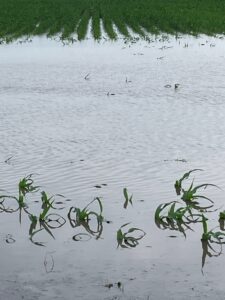
Figure 5: Ponds are back
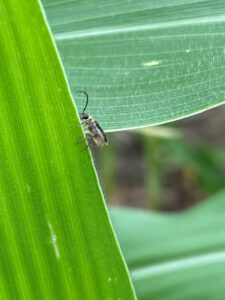
Figure 6: Western corn rootworm beetle adult
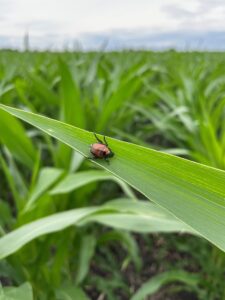
Figure 7: Japanese beetle
Reagan Tibbs – Commercial Agriculture Educator
Logan County
Soil Conditions: Near Normal
After a couple of weeks of hot and dry weather, the area finally received some much-needed precipitation on 6/25. Most of the area received more than an inch of rain, with some likely getting more. This rainfall will go a long way in replenishing the moisture available in the soil. More rain is forecast for today (6/26), with expected totals not quite as high as we saw yesterday. Crop growth did not slow down much during the last week. While some crops were starting to show signs of heat stress, the vast majority have continued to grow nicely around the area. Tassels are beginning to emerge in earlier-planted corn acres, and earlier-planted soybeans are developing blooms.
Doug Gucker – Local Food Systems and Small Farms Educator
Dewitt, Macon, and Piatt County
Soil Conditions: Near Normal
My 3-county area did receive some much needed thunderstorm activity over the past 5 days. The rainfall amounts have been quite variable, but all areas receiving some rain. Early planted corn is at the V12 stage and early planted soybeans at the R1 stage with pods forming on the lowest nodes. It is not unusual to see a field of V12 stage corn beside a later planted field with V6 stage corn. Wheat harvest is about wrapped up with area yields looking good in well managed fields.
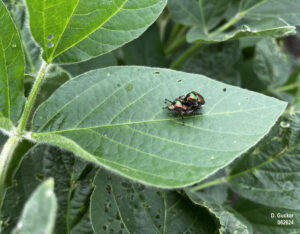
Figure 8: Japanese beetles are showing up in area soybean fields.

Figure 9: Early planted soybean plants have pods on lower nodes. and still blooming.

Figure 10: Watching a few soybean fields with amaranth plants showing tolerance to the synthetic auxins herbicides (Site of Action Group 4).
Nick Seiter – Extension Field Crops Entomologist
Champaign County
Soil Conditions: Mildly Dry (soil is drier than normal, plant growth may have slowed
We have started to see Japanese beetles at several of our research sites (including Ewing, Perry, Monmouth, and Urbana, IL) over the last week or so. Even very large populations of Japanese beetle usually cause only cosmetic injury, which is often concentrated on the field edge – remember, our economic threshold for soybean is 30% defoliation until R3, when it drops to 10%, and it is rare for us to exceed even this reduced threshold. In corn, silks need to be clipped to within half an inch of the ear tip before it’s worth controlling Japanese beetles, and this has to occur during pollen shed. This insect is notorious for chewing on brown silks that have already performed their function; if you spray them after silks are brown, you will certainly kill beetles, but it won’t make any difference whatsoever on corn yields.
We saw the first couple of corn rootworm beetles at our Urbana site on Monday this week. If you would like to participate in our regional trapping network (an effort to keep track of northern and western corn rootworm throughout the north central U.S. and Canada), send me an email at nseiter@illinois.edu with “corn rootworm trapping” in the subject – I will send you the traps and instructions. We also seek out populations of rootworm beetles from around Illinois each year to assay for Bt resistance; if you have a field with elevated beetle populations, send me an email with directions to the field and we will attempt to make a collection.
Talon Becker – Commercial Agriculture Specialist
Vermilion County
Soil Conditions: Near Normal
Some scattered rains over the past several days provided some relief to the crops I saw during my transect of the northern half of Vermilion County. Soils were not saturated to field capacity, but there was enough rain to replenish some of the soil moisture at shallow depths. As is fairly common this year, there was/is a wide range in crop growth stage between fields, and replanted areas could be seen fairly regularly, particularly in the northern third of the county. Soybeans ranged from VC to R2 and corn ranged from V3/V4 to almost VT with a few tassels starting to poke out. In fields I walked into, weed control in corn looked pretty good overall. However, there were a number of soybean fields with well-established waterhemp and marestail that will likely prove difficult to control with herbicides. Wheat fields that I saw in the area had been harvested, with the exception of about a third of one field. Some had been planted with the double-crop soy, but not everyone had made it that far quite yet.

Figure 11: Soybean field with extensive replanting.
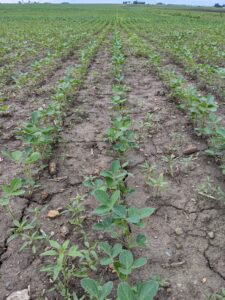
Figure 12: Soybean field with waterhemp.
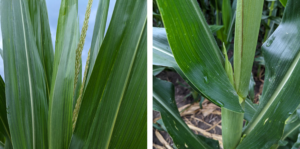
Figure 13: Corn approaching VT, showing early tassel and ear shoot emergence.





